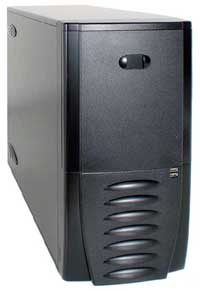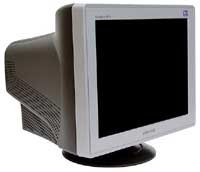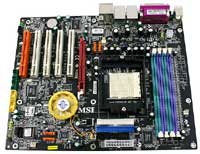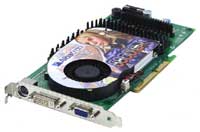AMD Mid-Range Gaming System
If you want some more
oomph in your system - say you like higher resolutions and antialiasing, or maybe you're a competitive online gamer - you could upgrade a few parts in the Budget System and end up with acceptable performance. We're going to kick it up another notch for the Mid-Range segment by improving nearly every component.
| Mid-Range AMD Athlon 64 System |
| Hardware |
Recommended Component |
Price |
| Processor |
AMD Athlon 64 3500+ 512K 2.2 GHz (939) 90nm |
285 |
| Motherboard |
MSI K8N Neo2 Platinum |
131 |
| Memory |
Mushkin Dual Pack 2x512 PC3200 2.5-3-3 |
159 |
| Video Card |
Albatron GeFORCE 6800 GT 256MB GDDR3 |
374 |
| Hard Drive |
Seagate 160GB SATA 7200RPM 8MB Model ST3160023AS |
93 |
| Optical Drive |
NEC DVD+/-RW Drive Model 3500A |
72 |
| Case and Power Supply |
Antec SLK3700-BQE with 350W |
91 |
| Display |
Samsung SyncMaster 997DF 19 CRT |
234 |
| Speakers |
Logitech Z-640 5.1 |
52 |
| Keyboard |
Logitech Internet Keyboard |
17 |
| Mouse |
Microsoft IntelliMouse Optical |
24 |
| Bottom Line |
|
1532 |

Click to enlarge. |
We return to several components that we have recommended in the past for the Mid-Range system. We've doubled the amount of RAM, and we've upgraded the case and PSU to the Antec SLK3700-BQE. It's not a flashy case, so if you're interested in that, you might look elsewhere. Nevertheless, it is a well thought out design, and the use of dual 120mm fans provides ample cooling when you add in the front fan. For the monitor, we have upgraded to a 19" CRT, which has the ability to run at 1600x1200 with a 75 Hz refresh rate. The NEC FE991SB is also an option, although it costs $40 more. We have upgraded to a Serial ATA hard drive with 160GB storage capacity, again staying with Seagate and their five-year warranty. Most of the other base components remain the same, although we opted for the five-button Microsoft IntelliMouse Optical this time.

Click to enlarge. |
The major changes come in the selection of motherboard, CPU, and graphics card. This should come as no surprise, as we have already mentioned several times that these are the most important aspects of a gaming system. For the processor, we have upgraded to an Athlon 64 3500+. The raw clockspeed advantage is not that great, but our
initial tests of the 90nm parts show a slight performance increase relative to the older 130nm 3500+, particularly in games, and it also has better overclocking capabilities if you're interested in that. The power use of the 90 nm parts is also substantially lower than the 130 nm design. The total price increase is $20 relative to the 130nm part, so either one is fine. The motherboard that we have selected uses the NForce3 250 Ultra chipset, and it was also our Gold Editor's Choice in our
Socket 939 Motherboard Roundup. There are several socket 939 motherboards with similar features that use the VIA K8T800 Pro chipset, but we have stuck with the NVIDIA chipset as tests have shown that it has a slight performance advantage when used with an NVIDIA graphics card compared to boards using the VIA chipset. ATI boards do not incur any penalties either, should you choose to go that route. If you prefer the VIA based boards, the Abit AV8 and Asus A8V both received our Silver Editor's Choice.

Click to enlarge. |
Speaking of graphics, our recommendation goes to a GeForce 6800GT AGP model. With 16 pixel pipelines, a 350 MHz GPU core and 1 GHz GDDR3 RAM, it provides nearly twice the performance of the 9800 Pro and significantly more than the 6600GT as well. Performance doesn't vary much if at all between the various manufacturers, so we have selected the card that we could find for the lowest price. You could also look into spending a bit more for a BFG 6800GT OC model that comes factory overclocked or the Leadtek model with it's larger two-slot HSF, but otherwise there is not a whole lot to differentiate among the designs. For ATI lovers, the X800 Pro actually offers very similar performance to the 6800GT. It only has 12 pixel pipelines, but since they're clocked at 475 MHz instead of 350 MHz, it ends up as almost a tie. The 6800GT has faster RAM - 1 GHz compared to 900 MHz - and it also includes Shader Model 3.0 support, not to mention a lower price. If you can find the X800 Pro for less than the 6800GT, though, it's definitely worth considering.

Click to enlarge. |
Then again, the AGP socket could become something of a limitation for upgrades by that time. We have recently previewed the
NForce 4 chipset as well as
ATI's RX480. Both should be available for purchase before the end of the year, and the NVIDIA boards will likely start showing up by the end of this month. If you're considering a socket 939 platform, and assuming you're willing to pay the price premium, it could be worth waiting for the PCI Express motherboards to ship. We'll take a look at PCI Express costs with our Intel Mid-Range alternative. SLI is also a very attractive feature for those looking to buy one card now and upgrade later. All told, an SLI-capable system will probably cost about $100 more than an equivalent AGP setup, but with AGP you're stuck with one graphics card.














70 Comments
View All Comments
spartacvs - Wednesday, January 5, 2005 - link
I decided to wait and I'll most probably go for nforce4. One thing I reallly like about your guide is the fact that there is many budgets. Most of the guides provides 3 systems (budget, price/performance and power) but more systems is really helpfull.Careless Joe - Tuesday, January 4, 2005 - link
RE: the "Cheap" psu in the budget case. Its a re-badged fortron. Very reliable.JarredWalton - Saturday, December 4, 2004 - link
Just FYI, I recently upgraded from the integrated audio on my MSI K8N Neo Platinum to an Audigy 2 ZS. My benchmarks in Half-Life 2 (using a measley 9800 Pro) went up a whopping 1 FPS. It might matter more with a faster GPU, but for my setup the sound card didn't matter much. It did, however, eliminate some static/noise from the audio. I couldn't hear it on the speakers, but on headphones it was very noticeable.Was it worth $75? That depends on how much disposable income you have and how annoying any extra static is. Since I often use headphones on my PC at night (no need to wake the wife and neighbors), it was annoying enough for me that I went and spent the money. For most people - particularly those using moderate to cheap speakers - you probably wouldn't notice.
SDA - Saturday, December 4, 2004 - link
Jarred, very true.. I've seen people defend PowerStream purchases after being told that they're the same as Tagans (which I don't do, by the way; I hate to even implicitly insult something that someone else owns) by saying that OCZ is a good name and is better-recognized, as if that really has anything to do with PSU performance. If you ask me, I don't think that sort of thing should really be factored into recommendations.. if someone wants to pay more for a brand name (when it has been demonstrated that there's no functional advantage), they're probably in the minority. (If someone wants to pay more for the PowerStream's looks, they need 20ccs of taste, stat. .. kidding, PowerStream owners ;)Oh, and spartacvs, just remember that integrated audio (non-SoundStorm integrated audio, anyway) will eat more CPU than a dedicated sound card will. It's not much of a big deal with today's overpowered PCs, if you ask me, and you still get plenty of bang for your buck (infinite bang for your buck, actually, since integrated audio is free).
spartacvs - Friday, December 3, 2004 - link
JarredWalton, yes, I think I understand your argument: AGPat the end of his life and PCIe is comming in.I had bad information about integrated audio. Integrated audio is not fantastic but I'm sure it'll be a majhor improvment over my old sb live!value 4.1... And, as I said, it's a way to save a few dollars. Something I, unfortunately, have to be very cautious these days :(
Thank you very much for your wise comments.
JarredWalton - Friday, December 3, 2004 - link
SDA - I understand that the internals are the same. For some people, however, the outside (and the brand) will matter. It doesn't bother me much, but convincing others of this is more difficult to do. I always prefer the weight test for PSUs (assuming you're at a store where you can pick up the PSU). All things being apparently equal, always go with the heavier PSU. :)Spartacvs - *all* motherboards include integrated audio these days. What Nforce4 doesn't include is the SoundStorm audio that was in Nforce1 and Nforce2 (certain models). NVIDIA is supposed to be working on a high-definition audio solution, but when that will actually arrive is a little difficult to say. The audio that will be on Nforce4 is the same as what is on most Nforce3 boards these days, so don't worry too much about that. If audio is really important to you, pick up a Creative Audigy 2 ZS (for games) or the M-Audio Revolution 7.1 (for more serious audio work).
SDA - Friday, December 3, 2004 - link
That depends on your definition of close, Jarred ;) The only real differences between them are cosmetic (shell, sticker, brand). The components, layout, and design are nearly identical.If you're having trouble with this concept, here's a parallel for you: Alienware's older notebooks (before they switched to Uniwill) and equivalent Sager notebooks (with a comparable configuration, obviously). Same platform, same layouts, same chassis, same components (possible that they used different brands of memory or something, but that's about it), same party assembling them; the differences are almost entirely cosmetic, and the ones that aren't don't apply to functionality.
Hopefully this is all a little clearer now, the world of computer hardware is really far too convoluted for its own good..
spartacvs - Thursday, December 2, 2004 - link
Ok, thanks for you answer. The place I want to buy have most of the memory brands. It's just muskin, they have only a few models.As for the MB. What I don't like about nforce4 is the lack of integrated audio. It increase the price tag a little bit more and I'm tight on money :(
JarredWalton - Thursday, December 2, 2004 - link
SDA - Just pointing out that they're not identical. Close, perhaps, and which you like more is probably more a matter of preference, but they certainly aren't identical.Spartcvs - Corsair, GEIL, Kingston, OCZ, and quite a few others are decent RAM. For value RAM, Kingston and Corsair are probably the most widely spread, but I don't really know what other countries are like in terms of availability. The difference between the motherboards is more difficult to quantify. I really like Abit boards, but I'm not as keen on the VIA chipset - NVIDIA just seems more stable in my experience. Either one is still a fine motherboard, and there are several other socket 939 NForce3 250 boards available. Now, though, waiting for NForce4 non-SLI might be a good idea - get one of those for ~$130 and get a 6600GT PCIe card.
spartacvs - Thursday, December 2, 2004 - link
Hey guys, I have a few questions.Fisrt, I do not overclock my system and will most probaly go with the Antec 2650 case because it's smaller and still a good case. Will also take the 120 GB HD because 160 is overkill for me (hey I hardly fullfill my actual 40 GB).
I hesitate between the abit board and the msi one. What do I lose going for the abit rather than the msi? The Abit is a via chipset, right?
Where I want to buy they don't have much of the mushkin memory. Can you recommand another brand (and model please because there is so many type of memory modules, it's easy to be lost).
Thanks